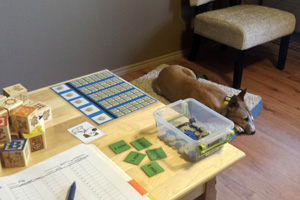Autism spectrum disorder (ASD) is one of the most widely and deeply researched topics in child development as researchers constantly look for answers into not only its cause but the best way to treat the problematic symptoms of the disorder once diagnosed.
Effects of the various types of ASD include deficits in social communication and interaction, repetitive or restricted behavior, sensory issues and cognitive delays. These traits prevent children on the spectrum from performing or completing tasks in the same timeliness or fashion as other children.
Often, in order to get children with ASD to complete tasks, a reward-based system is implemented, where the child is given a toy or some other form of reward. But the offer of a reward doesn’t always guarantee completion of the task.
One Texas Tech University researcher is part of a team taking a unique look at this system by providing access to therapy dogs as the reward, allowing students who complete certain academic tasks to spend time with the pooch, with the hope that potential interaction further motivates them to complete those tasks.
“It is a reward-based program,” said Alexandra Protopopova, a behavioral analyst and assistant professor in companion animal science in the Department of Animal & Food Sciences. “There is a second component to it, however, in that dogs, just by being dogs, may alleviate stress. Potentially, the dogs create a more pleasant environment and offer emotional support during academic sessions.”
“So, by mediating that stress level, the dogs may improve learning and potentially improve other outcomes as well as being a reward for the child ruing work.”

The dogs create a more pleasant environment and offer emotional support during academic sessions. Photo by Texas Tech University
Protopopova is an expert in behavior issues with dogs across a wide array of subjects, from interaction with children with ASD to analyzing what behaviors are more attractive for potential adopters and ways to bring those behaviors out to improve adoption rates.
But she said the methods and philosophies of how behavior works in animals is, at the core, the same as it is in children, and it is that connection that made this current research both attractive and interesting.
“With an iPad or toy as a reward, a child might become bored over time,” Protopopova said. “With a dog you might see the exact opposite situation over time where the child grows attached to the dog and the quality of the reward grows as well.”
Emotional interaction
Upon arriving at Texas Tech, Protopopova had a colleague in the College of Education, professor Jeanne Donaldson, who is now at Louisiana State University, and wanted to immediately connect the college and the Burkhart Center for Autism Education and Research with the Department of Animal & Food Sciences. The most natural way to make that connection, she said was to incorporate therapy dogs with the research being done involving applied behavior analysis in children with disabilities.
“Social behavior and social interaction has been an often neglected component of these kinds of programs,” Protopopova said, “and that is something researchers have attempted to improve, that social behavior and communication. There is some evidence that dogs or animals in general occasionally could bring out that social connection. That part of the research is definitely attractive to us.”
Measuring the effectiveness of using therapy dogs as a reward for academic performance in children with ASD was performed in two areas. The first was done biologically; stress responses were detected through the collection of saliva. Breanna Harris, a research assistant professor in the Department of Biological Sciences, used salivary cortisol, a stress hormone, to determine a student’s stress level in regard to anticipating interaction with the dog.
The second aspect of measuring effectiveness was done by observing the rate of work in the children and how motivated the children were to engage in academic tasks. Each child was given an individual task based on his or her education level, so those tasks involved the same things they were learning in school at the time or what parents had indicated the child needed extra help with.
A control condition was created where there were not rewards and children received praise only for engaging in academic tasks. A second control group saw children work toward receiving inanimate leisure items such as iPads or toys, which Protopopova said have been proven through prior research to be effective motivational tactics.
Two other control conditions involved the therapy dogs. One condition involved the dogs being used as a reward for work performed and would be present only after that work was completed. The second condition was what Protopopova termed more of the typical animal assisted intervention where the dog was continuously present in the room.
The conditions where there was no reward at all and where the dog was constantly around proved to be the most ineffective methods of motivation, researchers found. The two conditions where there were rewards provided upon completion of the work were the most effective; being rewarded with spending time with the therapy dog proved the most effective for some children.
“In fact, for most of the children, this was very useful as a reward because the dog motivated them quite a bit to do the work,” Protopopova said. “We did find, surprisingly to me, that one participant did in fact work where we hypothesized he wouldn’t during a session where the dog was present but not as a reward.”
Improvement over time
Single-use incidents of using the therapy dog show one thing, but the researchers wanted to determine whether prolonged exposure to the availability of a therapy dog as a reward for performing work continues those results.
For that reason, in this first study, children stayed in the program for anywhere from four to nine months to see if using the same dog repeatedly fosters the child’s attachment to the dog.
Prior to the child beginning the program, he or she is given a behavioral preference assessment where the child is asked to choose his or her favorite thing in the room, whether it’s a toy, an electronic device, a dog, etc. They also were given the choice of performing the academic test instead. At the end of the program, the child is tested again with the same assessment to see if their preferences had changed.
“We wanted to see how all these preferences for inanimate objects or activities changed,” Protopopova said. “Right now we are still collecting the final pieces of data because we’re still finishing up with a couple of participants. We don’t yet have the clear answers there, but it’s not as straightforward as we imagined, either. For some of the children, we did not see the attachment we hypothesized, or at least any evidence of it in our data so far. But it’s too early to tell.”
Protopopova said one of the advantages of this study is its single-subject design where each child’s program or sessions are designed specifically for that child’s needs. That will allow, if the program is used outside of an educational setting, for other children to enter the program with a focus on their unique behaviors and what is best to encourage them to learn difficult academic or self-care tasks in a non-stressful learning environment.
She said one family in the original group took the data gathered about their child and obtained a dog and will train it as a service dog because of the benefits the data showed for their child.
“This is definitely a strength,” Protopopova said. “Instead of a group design and us concluding that the average child would benefit from some procedure, which is not really that meaningful to individual families, we can give each family specific answers whether their child would or would not benefit from a dog.”
One major question to come out of the preliminary research, she said, is whether using a shelter dog to encourage behavior can be used to determine the severity of the disability. Does it work on children who are higher- or lower-functioning?
Protopopova and other researchers are beginning another one to answer new questions that rose from the original, smaller study.
The larger study will involve at least 30 children, and they are actively recruiting children to enter the study. Those children must be between the ages of 2 and 14 with autism spectrum disorder and/or other developmental disabilities.
The hope is the larger study will allow the research to be used in schools and centers on a regular basis.
“There we can answer more generalized questions,” Protopopova said. “How useful is this and who is it most useful for? Can we tell which children are going to benefit and which ones will not? So when we get those answers we are going to be a bit closer to really giving that program out to schools to say, ‘we have strong evidence that it will be useful for this person or not for this person.”
Source: Texas Tech University media statement











